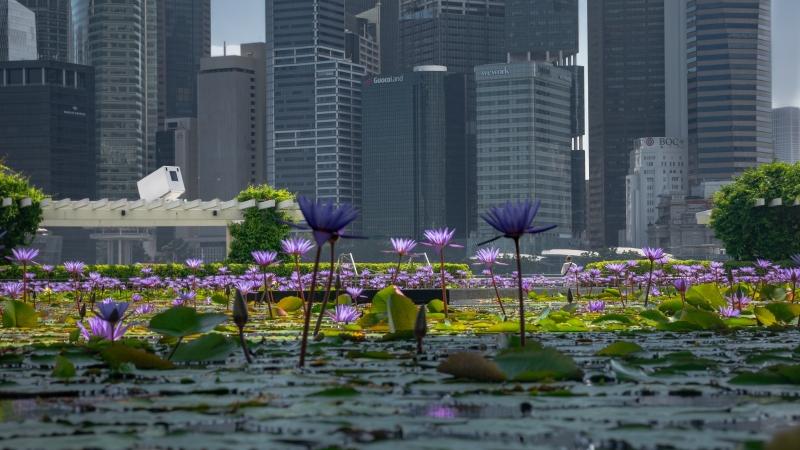 Photo by Filipe Freitas on Unsplash
Photo by Filipe Freitas on Unsplash
Biophilic design sweeps through Singapore's buildings as property owners go green
Incorporating nature-inspired building elements boosts occupant productivity, says an architecture expert.
With Singapore actively working to create an environment that is not only sustainable but also a stress-free one, especially for its professionals, more and more buildings in the country have been adopting biophilic design.
“Biophilic design engenders spaces that resonate with tranquillity and rejuvenation,” Joe Fu, director for ONG&ONG Architecture, told Singapore Business Review.
Ultimately, Fu said such design mitigates stress levels and alleviates anxiety “as exposure to natural elements and patterns has been scientifically linked to a reduction in stress.”
“The rising tide of biophilic design principles has illuminated the positive impact on human well-being. The integration of biophilic elements within professional environments has emerged as a catalyst for heightened productivity and enhanced creativity,” Fu said.
The increasing popularity of biophilic design was also observed by Harvey Lukman, associate director of DP Architects (DPA) and Khoo Poh Bin, deputy managing director of DCA Architects.
“Singapore has been actively promoting the incorporation of sustainable architecture into its initiatives, aiming to maximise the utilisation of its limited land space. The prevalence of sustainable and biophilic design, along with the creation of spaces that embrace these principles to generate memorable experiences, has become a significant trend in the realm of architecture locally,” Khoo said.
Lukman said the rising number of buildings in Singapore with greenery landscapes and sky gardens and terraces, reflects the popularity of biophilic design amongst property owners and developers.
Sustainable architecture
Biophilic design is only one facet of sustainable architecture that is being integrated into projects across Singapore.
In a bid to even make buildings with less ecological footprint, architects also incorporate energy-efficient systems and environmentally friendly materials into their designs.
“Buildings are designed to minimise energy consumption through strategies such as passive solar design, efficient insulation, and shading devices that reduce heat gain. The integration of energy-efficient lighting, heating, ventilation and air conditioning (HVAC) systems, and smart controls helps further reduce energy use,” Fu said.
Lukman shared a similar sentiment, saying: “We are seeing modern interpretation of tropical architecture in the use of passive design strategies such as cross ventilation, ceiling fans and deep overhangs.”
Cross-ventilation and other cooling strategies such as stack effect are crucial for Singapore’s building given its warm climate, said Fu.
Other green design features that are gaining popularity in Singapore include vertical gardens and green roofs, and solar energy utilisation.
“Solar panels are increasingly incorporated into building designs to harness solar energy for power generation,” said Khoo.
Fu said use of solar panels and other renewable energy sources in building designs also help “reduce reliance on fossil fuels and contribute to carbon emissions reduction.”
Lukman believes the use of alternative clean energy sources such as solar power is still at its infancy and believes more energy harvesting innovations will “shape the way architects design” in the future.
“The increasing adoption of solar panels, for example, will impact our roofscape design,” Lukman added.
Conservation
For Singapore’s older and existing buildings, Lukman said adaptive reuse and conservation are good sustainable approaches. Lukman said these approaches allow architects to rejuvenate old buildings and give them a new lease of life whilst reducing embodied carbon emission.
“The adaptive reuse of the Golden Mile Complex, a strata-titled development , is a major achievement. We are able to extend the lifespan of the building and add value to the development without rebuilding it from scratch,” he said.
The DPA expert added that adaptive reuse and conservation also preserves Singapore’s social values and architectural heritage.
The trend of preserving and repurposing old or conserved buildings also emphasises the “importance of historical layers in the urban landscape,” said Fu.
“Architectural interventions celebrated the coexistence of different eras, telling a story of continuity and change,” he said.
Smart buildings
Creation of green buildings also demand for smart technologies.
“Smart building technologies enable the optimisation of energy use, lighting, ventilation, and other building systems, making buildings more environmentally friendly and cost-effective to operate,” Khoo said.
“Architects and designers can create integrated building systems that communicate and work together seamlessly. For instance, lighting, HVAC, security, and access control systems can be interconnected, allowing for better control and management,” he added.
Technology and digital tools have played a vital role not only in helping architects design eco-friendly buildings, but also in their day-to-day operations.
DPA, for example, has developed a first-of-its-kind prop-tech marketplace, named Spaceworx, with its tech partner Eutech Group, which facilitates and simplifies the procurement, integration, and implementation of digital solutions in building projects.
According to Lukman, the platform also enables building owners to provide digital services to their tenants and monitor how the spaces and energy in their buildings are used.
Another digital solution that DPA offers is the Digital Twin Explorer, jointly developed with Vizzio Technologies, which not only provides a digital twin with 3D models but also creates environmental design simulations and presents realistic 3D visuals of the actual urban environment with video walkthroughs.
Khoo, for his part, said digital tools help architects create a hands-on experience for their clients which, in turn, help the latter grasp the “design's scale, proportions, and spatial relationships.”
“Technology enhances client engagement and understanding by enabling architects to present designs in interactive, immersive, and informative ways. This fosters better collaboration, more informed decision-making, and ultimately, a more successful project outcome that meets or exceeds clients' needs and expectations,” he said.
























 Advertise
Advertise










